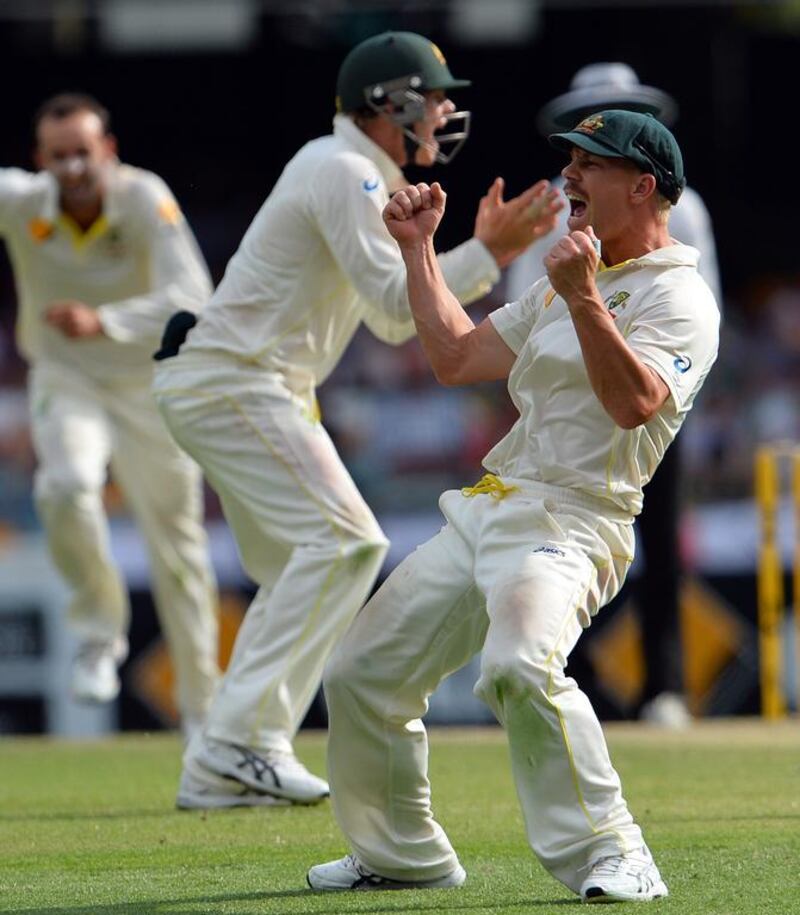In the space of less than 24 hours, we saw two of sport’s great rivalries come to life.
First, Everton and Liverpool contested a Merseyside derby – the 221st – that was so packed with incident it left a viewer giddy. Some of the defending might have had old stalwarts like Everton’s Kevin Ratcliffe and Liverpool’s Alan Hansen tearing out a hair or three, but the speed and verve with which both sides attacked was breathtaking.
Luis Suarez produced a perfect free kick, Romelu Lukaku ran Liverpool’s defence ragged in the final stages, and Daniel Sturridge came on to salvage a draw with a deft header that once again drew attention to the quality of Steven Gerrard’s delivery.
On Sunday morning, half a world away, Mitchell Johnson and Australia bullied England in a 381-run defeat in the first Ashes Test. England arrived at the Gabba firm favourites to retain the urn, but Johnson’s searing pace, Ryan Harris’s skill and bustle, and Nathan Lyon’s excellent use of the bounce on offer blew them away.
It certainly was not the sort of pitch on which you lose 20 wickets for 315 runs.
England’s frailty against the short ball, especially once Johnson started cranking up the speed to near 150kph, was yet another reminder that few batsmen fancy taking on genuine pace on surfaces where it is not neutered.
Both matches saw plenty of edge, too. Kevin Mirallas could have been sent off for an ugly, knee-high, studs-up lunge at Suarez, while Gerrard went into an aerial challenge leading with his elbow. Even the Liverpool physio got involved when he came on to treat Suarez.
In Brisbane, when England’s James Anderson came to the middle, George Bailey was quickly in his ear. Michael Clarke, who has presided over a miserable run in 2013, then got up close and personal and suggested that Anderson would do well to avoid a broken limb.
For some, it was ugly. For others, it was a reminder of just how much is on the line when old rivals meet. Emotions run so high that even the placid individual becomes a snarling alley cat.
If you started following sport in the 1980s, these were two contests that nearly always guaranteed entertainment. There was another, too, especially if your origins were in the subcontinent. That decade, Pakistan and India played 22 Tests and 30 one-day internationals. Many of those Tests were forgettable draws, but there were a few that linger in the memory even as the protagonists move into their sixth and seventh decades.
In 1982/83 in Pakistan, Imran Khan devastated India with reverse swing, taking 40 wickets as the series was won 3-0. Sunil Gavaskar and Mohinder Amarnath batted with great courage, but the rest were no match for a rampant Pakistan. Gundappa Viswanath, whose exploits against Andy Roberts and other West Indian legends had won him such respect, was given such a working over that he never played for India again.
In India, in 1987, a comatose series came alive in Bangalore, on a pitch that could politely be described as a sandpit. In his final innings, Gavaskar scripted a masterly 96, but it was Pakistan that edged home by 16 runs.
There was plenty of banter and aggression on view as well. Javed Miandad once infuriated Dilip Doshi, the left-arm spinner, by repeatedly asking him what his room number was. When Doshi sought the intervention of Gavaskar, his captain, Miandad revealed with a smirk that he only wanted to know so that he could hit the ball there.
Miandad was, of course, the central figure in the most famous India-Pakistan cricket match of that era. In Sharjah, in 1986, Pakistan needed a boundary off the final ball to win the AustralAsia Cup final. Chetan Sharma strove for a yorker. It turned out to be a full toss that Miandad swiped over midwicket for six. India had edged the one-day rivalry until then, but that one shot would lead to more than a decade of Pakistani dominance, interrupted only by Indian wins in World Cup matches.
Sadly, political tensions meant that the teams played only three Tests in the 1990s, when the likes of Sachin Tendulkar, Wasim Akram and Waqar Younis were in their prime. Twelve Tests were staged between 2004 and 2007, when the relationship appeared to be on the mend, but nothing since. Even in the one-day arena, there have been only seven matches this decade.
It has meant that a generation of players and fans has grown up without really experiencing cricket’s most intense rivalry. Given the off-field situation, maybe that is a good thing. No one wants to see sportsmen burdened with being custodians of national honour.
Cricket, however, is certainly poorer for the lack of an utterly unique spectacle.
sports@thenational.ae





